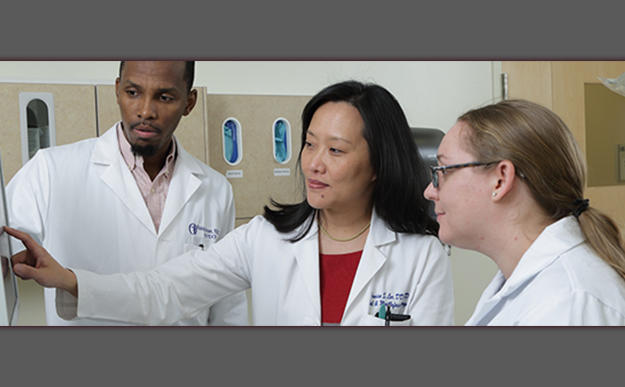Empowering women in oral surgery at the School of Dentistry

“You should lift more weights if you want to be successful in your career. You aren’t built to do this. You don’t look strong enough.”
No, Rachel Uppgaard, DDS, isn’t a body builder. She’s an oral maxillofacial surgeon, and a clinical assistant professor of oral surgery at the University of Minnesota’s School of Dentistry. And yet, she’s been told all these things throughout her career.
It’s not uncommon for women in oral surgery to experience discrimination--but continuing education programs for the School of Dentistry are working to combat that bias by featuring women making an impact in the field.
A recent Continuing Dental Education course hosted by Uppgaard and Angela Rake, DDS ’97, revealed the state of the gender disparity in oral surgery. Uppgaard began her presentation by sharing that up to 94% of practicing oral maxillofacial surgeons are men (Lee et al, JOMS 77:1532-1533, 2019 and Lee et al, JOMS 77:2179-2195, 2019).
She continued, sharing that as of 2019, while 34.5% of dentists were women, only 21.1% had specialized and about 8% of oral surgeons are women (Lee et al, JOMS 77:1532-1533, 2019 and Lee et al, JOMS 77:2179-2195, 2019).
Janice Lee, DDS, MD, MS, clinical director of the National Institute of Dental and Craniofacial Research and chief of the craniofacial anomalies and regeneration section, documented these findings in her two publications and noticed the same thing a few years ago, at the 2015 American Association of Oral Maxillofacial Surgery women’s summit. “I looked around and realized that 50% of people in our country are women, half of our med schools and dental schools are women--and yet, only about 8% of oral surgeons are women. What’s the problem?”
Lee, who will be the keynote speaker for the 31st Annual Waite Lectureship in April, decided to look at what we can control: rotations and residencies.
She and a team of researchers surveyed the experiences of residents and candidates for OMS programs, and what she found was shocking: women were twice as likely to encounter an unprofessional experience, such as gender bias or harassment, during their interview process--something that both men and women noticed during their experience. The interview is just the beginning; Uppgaard recalls experiences of herself and other women in her field feeling uncomfortable in the classroom, with male patients, and while practicing.
“It’s not just a ‘Me Too’ issue; it’s an ‘all of us’ issue,” Lee reflected. “It was important to me that people in our specialty know about this.”
 Uppgaard’s Continuing Education presentation shared the kicker to this disconnect: though women make up a significantly smaller portion of oral surgeons, their use of evidence-based medicine and performance on standardized exams tend to be at the same level if not higher than that of male surgeons. Moreover, women in other specialties tend to see better outcomes, perhaps due to differences in clinical practice like a patient-centered approach; for example, elderly hospitalized patients experience lower mortality rates and fewer readmissions when treated by women providers (Tsuwaga et al., JAMA 177(2):206-213, 2017).
Uppgaard’s Continuing Education presentation shared the kicker to this disconnect: though women make up a significantly smaller portion of oral surgeons, their use of evidence-based medicine and performance on standardized exams tend to be at the same level if not higher than that of male surgeons. Moreover, women in other specialties tend to see better outcomes, perhaps due to differences in clinical practice like a patient-centered approach; for example, elderly hospitalized patients experience lower mortality rates and fewer readmissions when treated by women providers (Tsuwaga et al., JAMA 177(2):206-213, 2017).
Lee says the best way to make a difference and increase the number of female oral surgeons is to raise awareness and create a dialogue that changes the culture. That’s why she’s excited to speak on the topic at the upcoming Waite lecture.
“I’ve given this talk a few times, and think it’s really important that the dialogue is there,” Lee explained. “I don’t think most people do these things intentionally--but we need to be making choices to engage diverse populations, invite women to give grand rounds, seek input. Then, a resident can look up and think, that’s someone who looks like me.”
Uppgaard and Rake are taking on that role at the University of Minnesota. Their recent day-long continuing education seminar focused on topics that matter to women, taught from the perspective of two female experts. Uppgaard shared insights on improving patient communication, posture and ergonomic considerations, and finding the right tools to become a better surgeon.
When it comes to procedures like extracting teeth, “it’s about finesse, not force,” she reminded attendees, encouraging them that it’s not all brute strength and size.
Rake followed Uppgaard’s presentation by sharing her experience with surgical and nonsurgical removal of teeth. She also reflected on incidents of bias she and her colleagues had experienced, and encouraged attendees, saying “we have things that are unique to clinical practice that we can share and learn from one another.” She shared her expertise on impacted teeth, the opioid crisis, and post-operative pain management.
These kinds of presentations are crucial for inspiring young women to join the ranks of oral surgeons and working toward a culture shift. At the end of her recent piece in the Journal of Oral Maxillofacial Surgery, Lee challenged the specialty to create an environment that results in at least 30% of those in the specialty being women within five years. She chose that percentage based on sociological evidence that a 30% minority is enough to begin to change the culture and dynamic of an organization overall.
“If we can start there, if we can start seeing ⅓ of panels, grand rounds, leadership committees, being women, then we can start to see real change,” she said.
Learn more and register for the Waite Lectureship, featuring keynote Janice Lee, on April 17.